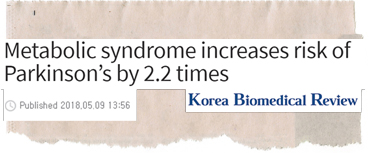HYPE?
Media portrayal:

HOPE?
Scientific interpretation:
Metabolic syndrome increases PD risk
Original article: Metabolic syndrome and risk of Parkinson disease: A nationwide cohort study: August 21, 2018: https://journals.plos.org/plosmedicine/article?id=10.1371/journal.pmed.1002640
The takeaway
The individual components of metabolic syndrome, which refers to elevations in blood pressure, blood glucose and lipids as well as abdominal fat deposition, individually and collectively increase the risk for Parkinson’s.
Why is it important?
This study has important clinical implications. It adds to the number of clinical tools that can be used to identify individuals at risk for Parkinson’s, and further highlights the importance of clinical and lifestyle intervention to combat metabolic syndrome.
Background
Metabolic syndrome is on the rise and directly linked to the obesity epidemic. It refers to a characteristic cluster of symptoms, that is, elevations in the triad of blood pressure, blood glucose and lipids, as well as increased fat deposition around the waist and abdomen. Collectively, these have been found to predict cardiovascular problems, diabetes and stroke. A recent nationwide Korean study asked whether metabolic syndrome also increases the risk for Parkinson’s.
The details
The researchers pulled historical health check-up data of just over 17 million individuals from the South Korean National Health Insurance Service database. They found that 5 years later, 44,205 had subsequently been diagnosed with Parkinson’s. The approximately 6 million individuals with metabolic syndrome at baseline were found to be at more than twice the risk (2.2 times greater) of a PD diagnosis compared to those who did not have metabolic syndrome. This was found to be the case after excluding the effects of other factors which included, age, gender, smoking, alcohol consumption, physical activity, income, body mass index, kidney function and history of stroke.
Each of the four aspects of metabolic syndrome, namely elevated blood pressure, blood sugar and lipids, and abdominal fat, contributed independently to increasing the risk for Parkinson’s. Individuals with these metabolic symptoms were at greater risk of Parkinson’s as the number of symptoms increased. This effect was more pronounced in women over 65.
However, as this was a retrospective cohort study, it is difficult to rule out the possibility of reverse causality – that is, since Parkinson’s has a long prodromal or silent phase, it is unclear that it is not driving the metabolic changes themselves. Nonetheless, the researchers were careful to exclude individuals who were diagnosed within 4 years prior to enrolment to avoid this source of error. Given the number of genetic and environmental factors which contribute to Parkinson’s, extrapolation from this to other populations around the world should proceed conservatively.
Next steps
Future work should focus on prospectively tracking individuals for a longer period of time in order to better understand the driving forces and associations between metabolic changes and Parkinson’s.
Where can I learn more?
See our summary on the Link between diabetes and Parkinson’s
https://www.parkinsonsmovement.com/glycation/
See our summary on insulin resistance in Parkinson’s
https://www.parkinsonsmovement.com/insulin-resistance/
Original article: Ga Eun Nam, Seon Mee Kim, Kyungdo Han, Nan Hee Kim, Hye Soo Chung, Jin Wook Kim, Byoungduck Han, Sung Jung Cho, Ji Hee Yu, Yong Gyu Park, Kyung Mook Choi: August 21, 2018. Metabolic syndrome and risk of Parkinson disease: A nationwide cohort study, available online: https://journals.plos.org/plosmedicine/article?id=10.1371/journal.pmed.1002640



